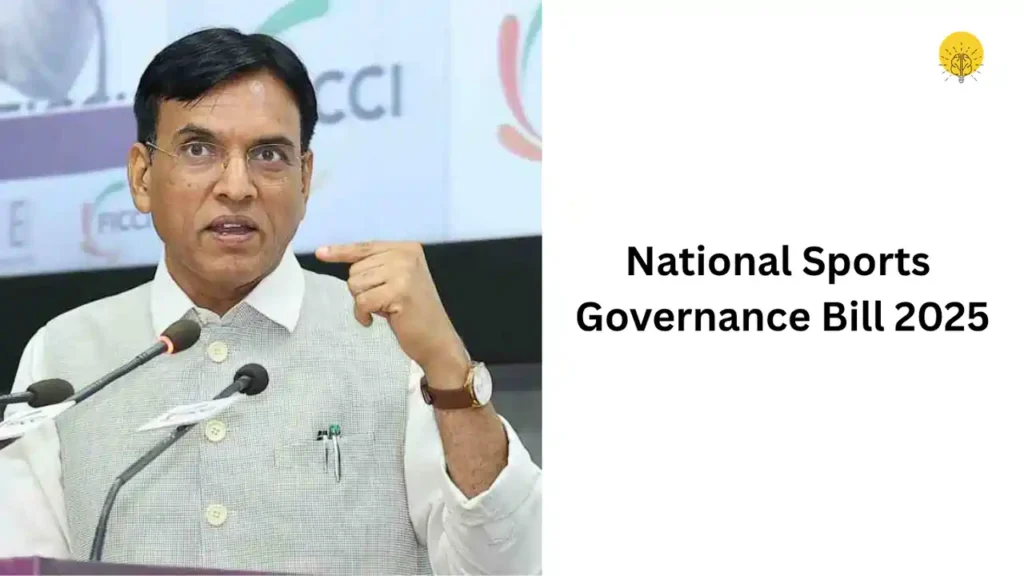New Delhi: On July 23, 2025, India took a monumental step toward transforming its sports ecosystem with the introduction of the National Sports Governance Bill in the Lok Sabha. This landmark legislation, tabled by Sports Minister Mansukh Mandaviya, aims to overhaul the governance of sports bodies, enhance transparency, ensure accountability, and elevate India’s performance on the global sports stage. By establishing robust frameworks like the National Sports Board (NSB), National Sports Tribunal, and National Sports Election Panel, the bill addresses long-standing issues of mismanagement, disputes, and lack of athlete representation in sports federations.

Objectives of the National Sports Governance Bill
The National Sports Governance Bill 2025 seeks to streamline sports administration in India, aligning it with international best practices. Its primary objectives include improving the governance of sports bodies, reducing disputes and litigation involving sports federations, and fostering better results in competitive sports. The bill establishes a structured framework to ensure transparency, accountability, and inclusivity, particularly for athletes and vulnerable groups like women and minor athletes. By introducing mandatory athlete representation, gender parity, and a robust grievance redressal system, the bill positions India to compete with global sporting powers like the USA, UK, China, and Japan, which have well-established sports governance laws.
Key Features of the National Sports Governance Bill
The bill introduces several transformative provisions to reform sports administration in India. Below is a detailed breakdown of its key components:
1. Establishment of National Sports Bodies (NSBs)
The bill establishes National Sports Bodies (NSBs) to govern various recognized sports organizations in India. These include:
- National Olympic Committee (NOC): The sole governing body for Olympic sports in India.
- National Paralympic Committee (NPC): The sole authority for Paralympic sports.
- National Sports Federation (NSF) and Regional Sports Federation (RSF): These bodies will oversee specific sports at national and regional levels.
Each NSB must formulate a Code of Ethics aligned with international best practices, ensuring ethical governance and accountability. Additionally, NSBs are required to implement a Safe Sports Policy and a grievance redressal mechanism to protect vulnerable groups, such as women and minor athletes, from exploitation and abuse.
2. National Sports Board (NSB)
The National Sports Board is a cornerstone of the bill, designed to act as a regulatory body akin to the Securities and Exchange Board of India (SEBI) for sports. Its key functions include:
- Maintaining a Register: The NSB will maintain a comprehensive register of all National Sports Bodies.
- Granting or Suspending Recognition: The NSB has the authority to recognize or suspend NSFs based on compliance with governance standards. Non-compliance, such as failure to hold elections, irregularities in election procedures, or misuse of public funds, can lead to suspension after consultation with relevant international bodies.
- Collaboration with International Bodies: The NSB will work with global sports organizations and NSBs to promote athlete welfare and develop sports in India.
- Issuing Guidelines: The NSB will issue guidelines to ensure compliance with international standards and best practices of the Olympic and sports movement.
- Ad Hoc Bodies: The NSB can constitute ad hoc administrative bodies or issue directives to NSBs to address governance issues.
The NSB’s chairperson and members will be appointed by the Central Government based on recommendations from a search-cum-selection committee. This committee will include the Cabinet Secretary or Secretary Sports as chairperson, the Director General of the Sports Authority of India, two experienced sports administrators, and one eminent sportsperson with accolades like the Dronacharya, Khel Ratna, or Arjuna Award. Appointees must have expertise in public administration, sports governance, sports law, or related fields, ensuring competent leadership.
3. National Sports Tribunal
The National Sports Tribunal is a game-changer for resolving sports-related disputes efficiently. With over 350 sports-related cases currently pending in Indian courts, the tribunal aims to fast-track dispute resolution, covering issues from athlete selection to federation elections. Key features include:
- Composition: The tribunal will consist of a chairperson (a sitting or retired Supreme Court judge or Chief Justice of a High Court) and two members with expertise in sports, public administration, or law.
- Powers: The tribunal will have all the powers of a civil court, and its orders can only be challenged in the Supreme Court, ensuring stable and swift jurisprudence.
- Procedure: The tribunal will formulate its own procedures to ensure speedy resolution, with appeals required within 30 days of its decisions (though the Supreme Court may allow late filings).
- Funding: Expenses will be covered by the Consolidated Fund of India, ensuring financial independence.
- Jurisdiction: Civil courts will have no jurisdiction over matters under the tribunal’s purview, reducing litigation delays.
The tribunal’s appointments will be made by the Central Government based on recommendations from a committee chaired by the Chief Justice of India or a Supreme Court judge, including the Sports Secretary and the Secretary of the Ministry of Law and Justice.
4. National Sports Election Panel
The National Sports Election Panel will ensure free and fair elections for the Executive and Athletes Committees of NSBs. Comprising retired members of the Election Commission of India, State Election Commissions, Chief Electoral Officers, or Deputy Election Commissioners with adequate experience, the panel will act as electoral officers. The NSB will maintain a roster of the panel, ensuring transparency and impartiality in the election process.
5. Right to Information (RTI) Act
All recognized sports organizations will fall under the Right to Information Act, 2005, for their functions, duties, and powers. This provision is likely to face resistance from the Board of Control for Cricket in India (BCCI), which has historically opposed government regulation, citing its financial independence. With cricket set to debut in the 2028 Olympics in T20 format, the BCCI may need to register as an NSF under the NSB, aligning with governance standards.
6. Age and Tenure Caps
The bill introduces significant changes to the age and tenure rules for sports administrators, addressing long-standing criticisms of entrenched leadership:
- Age Cap: Administrators must be under 70 at the time of filing nominations, with a possible extension to 75 if permitted by international statutes. This allows office-bearers to complete their tenure if elected before 70.
- Tenure: Office-bearers (President, Secretary General, Treasurer) can serve three consecutive terms (up to 12 years) and remain eligible for the Executive Committee after a cooling-off period. This ensures continuity while retaining competent leaders.
7. Executive Committee Composition
The bill caps the Executive Committee of sports bodies at 15 members to minimize financial burdens. It mandates:
- Gender Representation: At least four women must be included in the committee, aligning with global pushes for gender parity.
- Athlete Representation: At least two sportspersons of outstanding merit must be included, giving athletes a stronger voice in decision-making.
8. Government’s Discretionary Powers
The bill grants the Central Government significant authority:
- No Objection Certificate (NOC): Sports organizations using terms like “India,” “Indian,” or “National” or national insignia require an NOC from the government.
- Relaxation of Provisions: The government can relax bill provisions in the public interest.
- Directions: The government can issue directions to the NSB or other entities for efficient administration.
- Restrictions: In extraordinary circumstances, the government can impose restrictions on national team participation in the national interest.
9. Safe Sports Policy and Grievance Redressal
The bill mandates a Safe Sports Policy to protect vulnerable groups, particularly women and minor athletes. NSBs must establish grievance redressal mechanisms to address complaints promptly and fairly, fostering a safer environment for athletes.
Journey of the National Sports Governance Bill
The bill’s introduction marks the culmination of a journey that began in 2011 under then-Sports Minister Ajay Maken, who pushed for legislation to set benchmarks for sports administrators. The timeline includes:
- 2011: The Ministry drafted the National Sports Development Bill, which faced opposition due to strict age and tenure caps.
- 2013: A revised draft was released for public feedback but was not pursued. The Delhi High Court upheld the National Sports Code 2011.
- 2015: A Working Group was formed to redraft the Sports Code, but its inclusion of Indian Olympic Association (IOA) officials led to conflict-of-interest challenges in the Delhi High Court.
- 2017: A committee under Sports Secretary Injeti Srinivas, including sports icons like Abhinav Bindra, Anju Bobby George, and Prakash Padukone, drafted the National Code for Good Governance in Sports, 2017. The Delhi High Court ordered the report submitted in a sealed cover.
- 2019: An Expert Committee under Justice (Retd.) Mukundakam Sharma reviewed the 2017 draft but was stayed by the Delhi High Court.
- 2024: The Draft National Sports Governance Bill was released for public comments, receiving over 700 responses. Extensive consultations were held with the IOA, NSFs, athletes, coaches, legal experts, and international bodies like the International Olympic Committee, World Athletics, FIFA, and the International Hockey Federation (FIH).
- 2025: The bill was finalized and tabled in the Lok Sabha on July 23.
Sports Minister Mansukh Mandaviya credited Ajay Maken for laying the foundation with the National Sports Code 2011, which established good governance practices essential for sports development.
Differences from the National Sports Code
The National Sports Governance Bill introduces significant improvements over the National Sports Code 2011:
- Age Cap: The Sports Code capped administrator age at 70, while the bill allows tenure completion if elected before 70, with a possible extension to 75 per international statutes.
- Tenure: The Sports Code allowed three terms with a cooling-off period after two for the President and two terms for Treasurer and Secretary. The bill permits three consecutive 12-year terms for all three roles, with eligibility for the Executive Committee after a cooling-off period.
- Executive Committee: The Sports Code had no mandatory women’s representation and capped the committee at 15 members. The bill mandates four women and two eminent sportspersons.
- Regulatory Body: The Sports Code lacked a regulatory body, leaving recognition powers with the Sports Ministry. The bill establishes the NSB to oversee NSFs.
- Additional Bodies: The bill introduces the National Sports Tribunal, National Sports Election Panel, and Ethics Commission, absent in the Sports Code, to enhance dispute resolution, election integrity, and ethical governance.
Impact on Indian Sports and the BCCI
The bill promises to transform Indian sports by:
- Enhancing Transparency: The RTI Act’s inclusion ensures public accountability.
- Empowering Athletes: Mandatory athlete representation gives athletes a voice in governance.
- Reducing Litigation: The National Sports Tribunal will streamline dispute resolution.
- Promoting Gender Parity: Mandatory women’s representation aligns with global standards.
- Strengthening Governance: The NSB’s oversight will curb mismanagement and financial irregularities.
However, the bill’s impact on the BCCI remains contentious. The BCCI, an autonomous body, has resisted government regulation, arguing it does not rely on public funds. With cricket’s inclusion in the 2028 Olympics, the BCCI may need to register as an NSF under the NSB, subjecting it to RTI and governance standards. This could spark legal battles, as the BCCI has historically opposed such oversight, a concern echoed when the Supreme Court’s Justice R M Lodha panel proposed BCCI reforms nearly a decade ago.
Concerns of Government Overreach
While the bill aims to clean up Indian sports administration, concerns about government overreach persist. The Central Government’s powers to appoint NSB and tribunal members, issue NOCs, relax provisions, and impose restrictions raise questions about autonomy. The success of the bill depends on appointing impartial, competent individuals free from conflicts of interest. Critics also worry that the National Sports Tribunal’s exclusive jurisdiction could limit athletes’ and administrators’ access to lower courts, potentially affecting their rights.
Conclusion
The National Sports Governance Bill 2025 is a bold step toward modernizing India’s sports administration. By establishing the National Sports Board, Tribunal, and Election Panel, mandating gender and athlete representation, and aligning with international standards, the bill addresses long-standing governance issues. Its success hinges on effective implementation and overcoming resistance from powerful bodies like the BCCI. As India prepares for the 2028 Olympics and aims to become a global sporting powerhouse, this legislation could be a game-changer, fostering transparency, accountability, and athlete welfare.
Frequently Asked Questions (FAQs)
1. What is the National Sports Governance Bill 2025, and what are its main objectives?
The National Sports Governance Bill 2025 is a landmark legislation introduced in the Lok Sabha on July 23, 2025, to overhaul sports administration in India. Its primary objectives are to improve governance of sports bodies, enhance transparency and accountability, reduce disputes and litigation involving sports federations, and boost India’s performance in global sports. The bill establishes key institutions like the National Sports Board, National Sports Tribunal, and National Sports Election Panel, while mandating athlete representation, gender parity, and a Safe Sports Policy to protect vulnerable groups.
2. How does the National Sports Governance Bill differ from the National Sports Code 2011?
The bill introduces significant improvements over the National Sports Code 2011. It relaxes the age cap for administrators to 70 (extendable to 75 per international statutes) and allows three consecutive 12-year terms for key office-bearers with eligibility for the Executive Committee after a cooling-off period. Unlike the Sports Code, it mandates four women and two eminent sportspersons in the Executive Committee, establishes the National Sports Board to oversee federations, and introduces the National Sports Tribunal and Election Panel for dispute resolution and fair elections, which were absent in the Sports Code.
3. What is the role of the National Sports Board (NSB) in the bill?
The National Sports Board (NSB) is a regulatory body tasked with overseeing National Sports Bodies (NSBs). Its functions include maintaining a register of NSBs, granting or suspending recognition of National Sports Federations (NSFs) based on compliance, collaborating with international sports bodies, and issuing guidelines to align with global standards. The NSB can also form ad hoc administrative bodies and has the power to suspend NSFs for election irregularities or financial mismanagement, ensuring robust governance and athlete welfare.
4. How will the National Sports Tribunal impact sports-related disputes in India?
The National Sports Tribunal will streamline the resolution of sports-related disputes, such as those concerning athlete selection or federation elections, by acting as a civil court with exclusive jurisdiction. Comprising a chairperson (a Supreme Court judge or High Court Chief Justice) and two experts, the tribunal aims to resolve over 350 pending cases efficiently. Its orders can only be challenged in the Supreme Court, reducing delays in lower courts and ensuring stable jurisprudence. Expenses are covered by the Consolidated Fund of India.
5. Why is the inclusion of the BCCI under the bill controversial?
The Board of Control for Cricket in India (BCCI) resists inclusion under the bill as it operates autonomously and does not rely on government funds. The bill requires all recognized sports organizations, including the BCCI (with cricket’s 2028 Olympic inclusion), to register as NSFs under the National Sports Board and comply with the Right to Information Act, 2005. The BCCI opposes this, citing its financial independence, which could lead to legal challenges. The bill’s success in regulating cricket governance remains a key point of contention.

